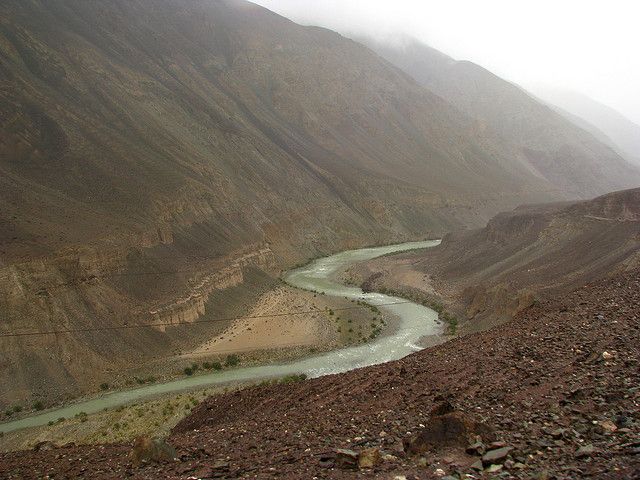Nearly 30 percent of the world's cotton supply comes from India and Pakistan, much of that from the Indus River Valley. On average, about 737 billion gallons are withdrawn from the Indus River annually to grow cotton—enough to provide Delhi residents with household water for more than two years.
"Pakistan's entire economy is driven by the textile industry," said Michael Kugelman, a South Asia expert at the Woodrow Wilson International Center for Scholars. "The problem with Pakistan's economy is that most of the major industries use a ton of water—textiles, sugar, wheat—and there's a tremendous amount of water that's not only used, but wasted," he added.
The same is true for India.
That impact is an important part of a complex water equation in countries already under strain from booming populations. More people means more demand for water to irrigate crops, cool machinery, and power cities. The Indus River, which begins in Indian-controlled Kashmir and flows through Pakistan on its way to the sea, is Pakistan's primary freshwater source—on which 90 percent of its agriculture depends—and a critical outlet of hydropower generation for both countries.
(Related: "Discover Fair Trade Cotton")
Downstream provinces are already feeling the strain, with some dried-out areas being abandoned by fishermen and farmers forced to move to cities. That increases competition between urban and rural communities for water. "In areas where you used to have raging rivers, you have, essentially, streams or even puddles and not much else," said Kugelman.
In years past, the coastal districts that lost their shares of the Indus' flows have become "economically orphaned," the poorest districts in the country, according to Pakistani water activist Mustafa Talpur. Because Pakistani civil society is weak, he says, corruption and deteriorating water distribution tend to go hand in hand.
In the port city of Karachi, which depends for its water on the Indus, water theft—in which public water is stolen from the pipes and sold from tankers in slums and around the city—may be a $500-million annual industry.
In the balance is the fate not only of people, but important aquatic species like the Indus River dolphin, which is now threatened to extinction by agricultural pollution and dams, among other pressures. Scientists estimate that fewer than 100 individuals remain.
Threat to Peace?
One of the potentially catastrophic consequences of the region's fragile water balance is the effect on political tensions.
In India, competition for water has a history of provoking conflict between communities. In Pakistan, water shortages have triggered food and energy crises that ignited riots and protests in some cities. Most troubling, Islamabad's diversions of water to upstream communities with ties to the government are inflaming sectarian loyalties and stoking unrest in the lower downstream region of Sindh.
But the issue also threatens the fragile peace that holds between the nations of India and Pakistan, two nuclear-armed rivals. Water has long been seen as a core strategic interest in the dispute over the Kashmir region, home to the Indus' headwaters. Since 1960, a delicate political accord called the Indus Waters Treaty has governed the sharing of the river's resources. But dwindling river flows will be harder to share as the populations in both countries grow and the per-capita water supply plummets.
Some growth models predict that by 2025, India's population will grow to triple what it was—and Pakistan's population to six times what it was—when the Indus treaty was signed. Lurking in the background are fears that climate change is speeding up the melting of the glaciers that feed the rive.
Mountain glaciers in Kashmir play a central role in regulating the river's flows, acting as a natural water storage tank that freezes precipitation in winter and releases it as meltwater in the summer. The Indus is dependent on glacial melting for as much as half of its flow. So its fate is uniquely tied to the health of the Himalayas. In the short term, higher glacial melt is expected to bring more intense flooding, like last year's devastating deluge.
Both countries are also racing to complete large hydroelectric dams along their respective stretches of the Kashmir river system, elevating tensions. India's projects are of a size and scope that many Pakistanis fear could be used to disrupt their hydropower efforts, as well as the timing of the flows on which Pakistani crops rely.
(Related: "Seven Simple Ways to Save Water")
"Many in Pakistan are worried that, being in control of upstream waters, India can easily run Pakistan dry either by diverting the flow of water by building storage dams or using up all the water through hydroelectric power schemes," said Pakistani security analyst Rifaat Hussain.
For years, Pakistani politicians have claimed India is responsible for Pakistan's water troubles. More recently, militant groups have picked up their rhetoric. Hafiz Saeed, the founder of the Pakistani militant group allegedly responsible for the 2008 terror attack in Mumbai, even accused India of "water terrorism."
Hope for the Future?
In the past few months, however, the situation has improved, according to Kugelman. "We've been hearing nearly unprecedented statements from very high-level Pakistani officials who have essentially acknowledged that India is not stealing Pakistan's water, and that Pakistan's water problems are essentially a function of internal mismanagement issues," he said. Militants are still griping, he said, "but not as shrilly."
This may be because the two countries are cooperating on water and other issues better than before, and because militants are now focusing less on their archenemy in India and more on coalition forces in Afghanistan.
"But I imagine this is momentary," said Kugelman. "The facts on the ground—the water constraints in both India and Pakistan—have not abated. They're both still very serious and getting worse."
What's needed, he says, is more conservation and adaptation—a smarter way of doing business.
